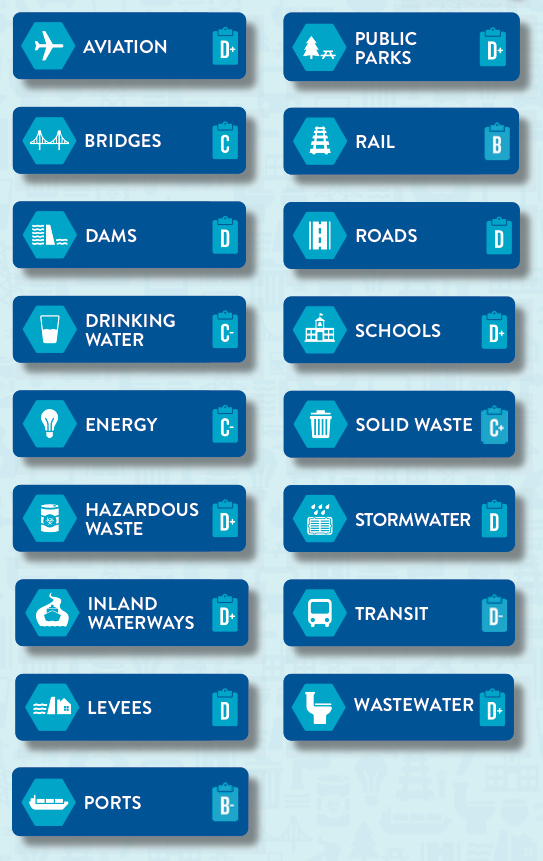The US is paying only about half its bill for adequate infrastructure, with dams, schools, roads, airports and transit systems all getting “Ds” in the latest quadrennial infrastructure “Report Card” issued by the American Society of Civil Engineers (ASCE).
Releasing the report on 3 March, ASCE warned that the total investment gap has gone from $2.1 trillion over 10 years to nearly $2.59 trillion over 10 years, and that a failure to close it would cost $10 trillion in lost GDP, $2.4 trillion in reduced exports and three million jobs by 2039.
That will translate to a cost of $3,300 a year for the average American household, or $63 a week.
“When we fail to invest in our infrastructure, we pay the price,” ASCE said.
“Poor roads and airports mean travel times increase. An ageing electric grid and inadequate water distribution make utilities unreliable. Problems like these translate into higher costs for businesses to manufacture and distribute goods and provide services. These higher costs, in turn, get passed along to workers and families.”
The warning came as a subcommittee of the US House Committee on Oversight and Reform launched an investigation on 3 March into the operator of Texas’ power grid, the Electric Reliability Council of Texas (ERCOT), for its part in leaving millions of Texans without electricity during the February storm that left dozens dead. It demanded documents relating to ERCOT’s preparations for extreme weather events going back to 2010.

Overall, 11 of 17 categories were stuck in the “D” range, which ASCE said was “a clear signal that our overdue bill on infrastructure is a long way from being paid off”
ASCE defines a “D” grade as one up from “F”, which means unfit for purpose, with assets being “in fair to poor condition and mostly below standard, with many elements approaching the end of their service life”.
“A large portion of the system exhibits significant deterioration,” it says. “Condition and capacity are of serious concern with strong risk of failure.”
There is some good news. For the first time in 20 years, US infrastructure’s grade point average hit C-, up from a D+ in the last report in 2017, helped by a “B” in rail and slight improvements in aviation, drinking water, energy, inland waterways and ports.
But bridges went down, slipping to a “C”, while stormwater, graded for the first time, received a “disappointing D”. Overall, 11 of 17 categories were stuck in the “D” range, which ASCE said was “a clear signal that our overdue bill on infrastructure is a long way from being paid off”.
One of the most pronounced funding gaps concerns the country’s 91,000 dams, of which the number of high-hazard-potential dams has more than doubled in the past two decades as development encroaches on once remote structures. ASCE cited the Association of State Dam Safety Officials’ estimation that the number of deficient high-hazard-potential dams now exceeds 2,300. ASCE said $93.6bn needed to be spent on dams this decade, while just $12.5bn had been earmarked for the period, leaving a gap of $81bn – more than -86%.
Schools represent the second biggest infrastructure expenditure after highways, and yet the data indicate that 53% of public school districts report the need to update or replace multiple building systems, including HVAC systems. More than a third of public schools have portable buildings due to capacity constraints, with 45% of these portable buildings in poor or fair condition. Meanwhile, as a share of the economy, state capital funding for schools was down 31% in fiscal year 2017 compared to 2008.
ASCE says schools need $810bn this decade but are set to receive $490bn, a gap of $380bn, or -56%.
Of America’s more than 617,000 bridges, 42% are at least 50 years old, and 46,154 of them are considered structurally deficient. Across these structurally deficient bridges, 178 million trips are taken every day. ASCE notes a recent estimate of the national backlog of bridge repair was $125bn, and that this work would not be complete until 2071 at the current rate of investment.
Spending on bridge rehabilitation should rise 58%, from $14.4bn a year to $22.7bn a year, to prevent “overwhelming” deterioration, ASCE says.
Roads got a “D”, with ASCE saying that more than 40% of the network is now in poor or mediocre condition. It calculates that deficient conditions force motorists to pay around $1,000 a year in wasted time and fuel. “Federal, state, and local governments will need to prioritize strategic investments dedicated to improving and preserving roadway conditions that increase public safety on the system we have in place, as well as plan for the roadways of the future, which will need to account for connected and autonomous vehicles,” ASCE said.
Top image: Flooded intersection in Austin, Texas during the thaw following the February 2021 snowstorm (Jno.skinner/CC BY-SA 4.0/)










